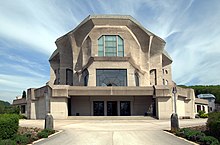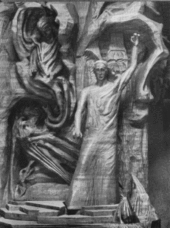~ ANTHROPOSOPHY ~
Anthroposophy is a path of knowledge, to guide the spiritual in the human being to the spiritual in the universe. It arises in people as a need of the heart and feeling life. Anthroposophy can be justified only to the degree that it satisfies this inner need. It may be acknowledged only by those who find within it what they themselves feel the need to seek. Therefore, anthroposophists are those who experience, as an essential need of life, certain questions on the nature of the human being and the universe, just as one experiences hunger and thirst.
— Rudolf Steiner, Anthroposophical Leading Thoughts, 1904
Anthroposophy is an amalgam of the Greek terms ἄνθρωπος (anthropos = "human") and σοφία (sophia = "wisdom"). An early English usage is recorded by Nathan Bailey (1742) as meaning "the knowledge of the nature of man."[19] Authors whose usage of the term predates Steiner's include occultist Agrippa von Nettesheim, alchemist Thomas Vaughan (Anthroposophia Theomagica), and philosopher Robert Zimmermann.
Steiner began using the term in the early 1900s as an alternative to the term theosophy (divine wisdom), a term central to the Theosophical Society, with which Steiner was associated at the time, and to a long tradition of European esotericists. Steiner probably first encountered the word "anthroposophy" in the work of Zimmermann, some of whose lectures in the University of Vienna he had attended while a student.
History
The early work of the founder of anthroposophy, Rudolf Steiner, culminated in his Philosophy of Freedom (also translated as The Philosophy of Spiritual Activity and Intuitive Thinking as a Spiritual Path). Here, Steiner developed a concept of free will based on inner experiences, especially those that occur in the creative activity of independent thought.
By the beginning of the twentieth century, Steiner's interests turned to explicitly spiritual areas of research. His work began to interest others interested in spiritual ideas; among these was the Theosophical Society. From 1900 on, thanks to the positive reception given to his ideas, Steiner focused increasingly on his work with the Theosophical Society becoming the secretary of its section in Germany in 1902. During the years of his leadership, membership increased dramatically, from a few individuals to sixty-nine Lodges.[11]
By 1907, a split between Steiner and the mainstream Theosophical Society had begun to become apparent. While the Society was oriented toward an Eastern and especially Indian approach, Steiner was trying to develop a path that embraced Christianity andnatural science. The split became irrevocable when Annie Besant, then president of the Theosophical Society, began to present the child Jiddu Krishnamurti as the reincarnated Christ. Steiner strongly objected and considered any comparison between Krishnamurti and Christ to be nonsense; many years later, Krishnamurti also repudiated the assertion. Steiner's continuing differences with Besant led him to separate from the Theosophical Society Adyar; he was followed by the great majority of the membership of the Theosophical Society's German Section, as well as members of other national sections.[11][12]
By this time, Steiner had reached considerable stature as a spiritual teacher.[13] He spoke about what he considered to be his direct experience of the Akashic Records (sometimes called the "Akasha Chronicle"), thought to be a spiritual chronicle of the history, pre-history, and future of the world and mankind. In a number of works,[14] Steiner described a path of inner development he felt would let anyone attain comparable spiritual experiences. Sound vision could be developed, in part, by practicing rigorous forms of ethical and cognitive self-discipline, concentration, and meditation; in particular, a person's moral development must precede the development of spiritual faculties.[1]
In 1912, the Anthroposophical Society was founded. After World War I, the Anthroposophical movement took on new directions. Projects such as schools, centers for those with special needs, organic farms and medical clinics were established, all inspired by anthroposophy.
In 1923, faced with differences between older members focusing on inner development and younger members eager to become active in the social transformations of the time, Steiner refounded the Society in an inclusive manner and established a School for Spiritual Science. As a spiritual basis for the refounded movement, Steiner wrote a "Foundation Stone Meditation" which remains a central meditative expression of anthroposophical ideas.
Steiner died just over a year later, in 1925. The Second World War temporarily hindered the anthroposophical movement in most of Continental Europe, as the Anthroposophical Society and most of its daughter movements (e.g. Steiner/Waldorf education) were banned by the National Socialists (Nazis);[15] virtually no anthroposophists ever joined the National Socialist Party.[16]
By 2007, national branches of the Anthroposophical Society had been established in fifty countries, and about 10,000 institutions around the world were working on the basis of anthroposophy.[17] In the same year, the Anthroposophical Society was called the "most important esoteric society in European history."
Spiritual knowledge and freedom
Anthroposophical proponents aim to extend the clarity of the scientific method to phenomena of human soul-life and to spiritual experiences. This requires developing new faculties of objective spiritual perception, which Steiner maintained was possible for humanity today. The steps of this process of inner development he identified as consciously achieved imagination, inspiration and intuition.[6] Steiner believed results of this form of spiritual research should be expressed in a way that can be understood and evaluated on the same basis as the results of natural science:[4] "The anthroposophical schooling of thinking leads to the development of a non-sensory, or so-called supersensory consciousness, whereby the spiritual researcher brings the experiences of this realm into ideas, concepts, and expressive language in a form which people can understand who do not yet have the capacity to achieve the supersensory experiences necessary for individual research."
Steiner hoped to form a spiritual movement that would free the individual from any external authority: "The most important problem of all human thinking is this: to comprehend the human being as a personality grounded in him or herself." For Steiner, the human capacity for rational thought would allow individuals to comprehend spiritual research on their own and bypass the danger of dependency on an authority.[21]
Steiner contrasted the anthroposophical approach with both conventional mysticism, which he considered lacking the clarity necessary for exact knowledge, andnatural science, which he considered arbitrarily limited to investigating the outer world.
Nature of the human being
Main article: Anthroposophical view of the human being
In Theosophy, Steiner suggested that human beings unite a physical body of substances gathered from (and that ultimately return to) the inorganic world; a life body (also called the etheric body), in common with all living creatures (including plants); a bearer ofsentience or consciousness (also called the astral body), in common with all animals; and the ego, which anchors the faculty of self-awareness unique to human beings.
Anthroposophy describes a broad evolution of human consciousness. Early stages of human evolution possess an intuitive perception of reality, including a clairvoyant perception of spiritual realities. Humanity has progressively evolved an increasing reliance on intellectual faculties and a corresponding loss of intuitive or clairvoyant experiences, which have become atavistic. The increasing intellectualization of consciousness, initially a progressive direction of evolution, has led to an excessive reliance onabstraction and a loss of contact with both natural and spiritual realities. However, to go further requires new capacities that combine the clarity of intellectual thought with the imagination, and beyond this with consciously achieved inspiration and intuitive insights.
Anthroposophy speaks of the reincarnation of the human spirit: that the human being passes between stages of existence, incarnating into an earthly body, living on earth, leaving the body behind and entering into the spiritual worlds before returning to be born again into a new life on earth. After the death of the physical body, the human spirit recapitulates the past life, perceiving its events as they were experienced by the objects of its actions. A complex transformation takes place between the review of the past life and the preparation for the next life. The individual's karmic condition eventually leads to a choice of parents, physical body, disposition, and capacities that provide the challenges and opportunities that further development requires, which includes karmically chosen tasks for the future life.
Steiner described some conditions that determine the interdependence of a person's lives, or karma.
Evolution
The anthroposophical view of evolution considers all animals to have evolved from an early, unspecialized form. As the least specialized animal, human beings have maintained the closest connection to the archetypal form;[25] contrary to the Darwinian conception of human evolution, all other animals devolve from this archetype.[26] The spiritual archetype originally created by spiritual beings was devoid of physical substance; only later did this descend into material existence on Earth.[27] In this view, human evolution has accompanied the Earth's evolution throughout the existence of the Earth.
Anthroposophy took over from Theosophy a complex system of cycles of world development and human evolution. The evolution of the world is said to have occurred in cycles. The first phase of the world consisted only of heat. In the second phase, a more active condition, light, and a more condensed, gaseous state separate out from the heat. In the third phase, a fluid state arose, as well as a sounding, forming energy. In the fourth (current) phase, solid physical matter first exists. This process is said to have been accompanied by an evolution of consciousness which led up to present human culture.
Ethics
The anthroposophical view is that good is found in the balance between two polar influences on world and human evolution. These are often described through their mythological embodiments as spiritual adversaries which endeavour to tempt and corrupt humanity, Lucifer and his counterpart Ahriman. These have both positive and negative aspects. Lucifer is the light spirit, which "plays on human pride and offers the delusion of divinity", but also motivates creativity and spirituality; Ahriman is the dark spirit that tempts human beings to "...deny [their] link with divinity and to live entirely on the material plane", but that also stimulates intellectuality andtechnology. Both figures exert a negative effect on humanity when their influence becomes misplaced or one-sided, yet their influences are necessary for human freedom to unfold.
Each human being has the task to find a balance between these opposing influences, and each is helped in this task by the mediation of the Representative of Humanity, also known as the Christ being, a spiritual entity who stands between and harmonizes the two extremes
"By anthroposophy I understand a scientific research of the spiritual world which sees through the one-sidedness of both normal, natural science and traditional mysticism. Anthroposophy seeks to develop those forces of soul not yet active in normal consciousness and science but which make possible such a penetration into the supersensible world."
Rudolf Steiner




